Toilet bowl does not hold water - how to troubleshoot
When the toilet tank does not hold water - this is an unpleasant breakdown, as water consumption increases, which is associated with additional costs, besides there is a constant unpleasant noise. Therefore, when the first signs of this malfunction occur, it must be immediately eliminated. Below we will look at how to do it yourself.
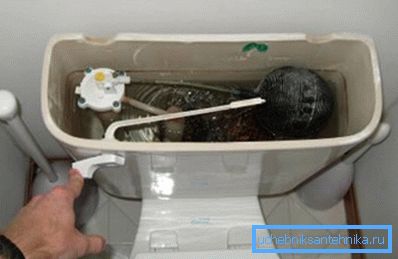
General information
Many people are afraid to "touch" the plumbing with their own hands and in the event of any damage cause specialists. However, the device of the cistern is quite simple and understandable, so that everyone can repair it without having any social knowledge. To do this, you need only the ability to handle elementary tools.
For some breakdowns, it may be necessary to replace broken parts. In this case, it is necessary to dismantle the defective items and come with them to the plumbing shop to find the right repair kit.
Separately, it should be said about the repair of a toilet cistern tank, which is a much more complicated procedure. This is due to the fact that the capacity is hidden in the installation, as a result of which it is necessary to disturb the decoration of the room. The tank itself in this case may differ from the traditional form, however, the principle of its operation is the same.
Tip! Many people do not know how much weight a toilet stand can withstand, so they are afraid to install it. However, if you look at the characteristics of this device, how many kg the hanging toilet bowl can withstand, it turns out that it is designed for a maximum weight of 450 kg, respectively, can withstand a person of any build and will have a considerable margin of safety.
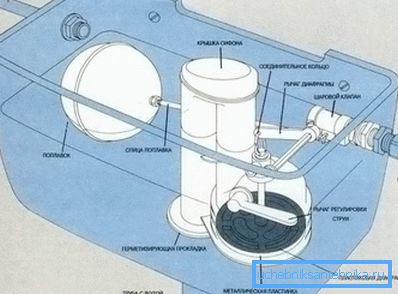
The device valves
The drain mechanism of the tank in the professional world of plumbers is called stop valves. Before proceeding with self-repair, you should understand how it works.
So, if an ignorant person opens the lid of the container, he will see only two parts there:
- Float mechanism;
- Drain mechanism.
Below we take a closer look at their device.
Note! The device of valves in your tank may differ slightly from that described in this article. But, in any case, this is a fairly simple mechanism, which is not difficult to understand.
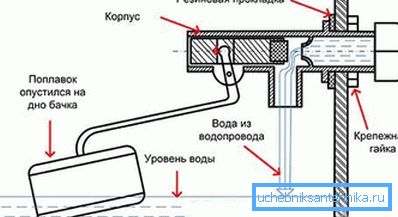
Float mechanism
The float mechanism consists of two parts:
- A housing with a membrane that cuts off the water supply;
- A float with a lever that adjusts the position of the membrane in the housing.
The water level can be adjusted by the position of the float.
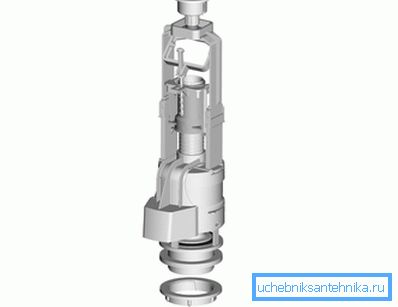
Drain mechanism
The device of the drain mechanism, as a rule, includes three main details:
- Valve;
- Housing;
- Button drain with leverage.
The principle of operation of this device is quite simple - the position of the movable valve, located in a plastic case, is changed using a system of levers as a result of pressing a button. In addition, there is an overflow in the tank, which directs excess water into the toilet bypassing the valve, which helps prevent overflow and, as a result, flooding the apartment.
Causes of tank leakage and their elimination
If the water in the toilet bowl does not hold, this can be due to two reasons:
| Float problem | The water level exceeds the allowable rate, and the water flows into the toilet through the overflow. |
| Valve problem | The device in the closed state for some reason misses the water. |
Below we take a closer look at the possible causes of faults in these mechanisms and their correction.
Tank overflow
Tank overflow can occur for the following reasons:
- Incorrectly adjusted float position - adjustment can be done in different ways, depending on the design of the valve. For example, if the lever is metal, then you just need to bend it gently. Plastic levers can have a ratchet or an adjusting screw.
- A hole in the float - in this case, the part can be temporarily sealed and then replaced.
- The float is covered with dirt - as it is not difficult to guess, the part just needs to be cleared of dirt.
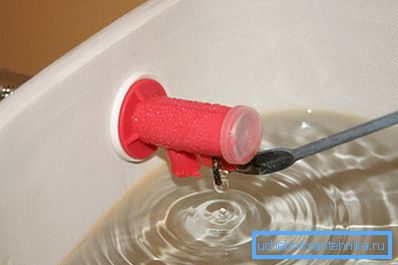
- Membrane malfunction - if the water does not overlap in any position of the lever of the float mechanism, then there is only one way out - to replace the stop valve. The price of the membrane is low and finding it on the market or in specialized stores is not difficult.
To dismantle the parts is not difficult. In some models, all fasteners are plastic, so dismantling can be performed even without tools.
Does not hold the valve
If the water supply is shut off, but the flow does not stop, it does not hold the valve in the toilet bowl.
There are two reasons for this failure:
- Dry rubber valve;
- Garbage has fallen under the valve.
In any case, to eliminate the problem, you will need to dismantle the valve of the toilet cistern. The design of the drain device may be different, respectively, the dismantling is also carried out in different ways. Most often, the mechanism is disassembled into two parts, with the result that you can get the valve.
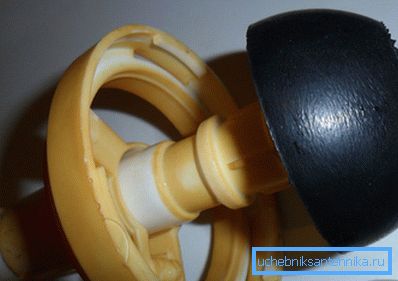
Instructions for resolving this problem are extremely simple:
- First of all, it is necessary to clean the valve and the drain hole from dirt;
- Then the device must be assembled and put in place;
- If the toilet still does not hold water, you need to disassemble the mechanism and replace the valve.
Other faults
In addition to the above, some other faults may occur in the drain system, the most common ones are listed below:
- The connection between the cistern and the toilet bowl is leaking - in this case it is necessary to completely dismantle the cistern to replace all the gaskets available, including the screw seals.

- Mechanical failure of any elements of valves - this problem can be solved only by replacing broken parts.
Note! Ceramic drainage tank can have a sufficiently large weight, so you need to work with it carefully so that it does not break.
That's actually all the information you need to know in order to repair such breakdowns of the toilet cistern as water flow.
Conclusion
The leakage of the tank is one of the most common problems. As we found out, you can fix it yourself without spending much time and effort. Moreover, in most cases you don’t even have to disassemble the mechanism, since it is enough to adjust the position of the float.
From the video in this article, you can learn some additional information on this topic.